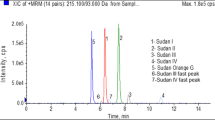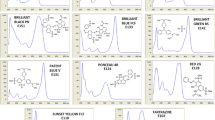Abstract
The present work describes the development and validation of a simple, quick and precise gas chromatography-mass spectrometry (GC-MS) method for the analysis of 23 azo dye breakdown products in paprika samples. After the extraction procedure, dyes were identified on an Agilent J&W DB-5ms Ultra Inert capillary column using dichloroethane as a sample dissolvent. Limits of detection (LODs) were comprised between 10.6 and 84.4 ng/mL. Accuracy values in the range of 90–104 % for the 23 azo dye breakdown products were obtained, and RSD% for the analysis of 2.4 μg/mL of each compound was below 4.6 % (n = 9). The recovery for the azo dyes in paprika samples was comprised between 71.2 ± 3.5 % (benzidine) and 118.9 ± 2.5 % (para-cresidine). Results of this study suggest that the developed method is suitable for detection and quantification of azo dye breakdown products in the range of 60–240 μg/kg paprika. In addition, this GC-MS method allowed the simultaneous determination of disperse orange 3 (azo dye) with high accuracy and precision. The method has numerous advantages such as simplicity, low cost, easy operation and short analysis time and constitutes an efficient method for the monitoring of a large number of azo dyes in food matrices.




Similar content being viewed by others
References
Ben Mansour H, Barillier D, Corroler D, Ghedira K, Chekir-Ghedira L, Mosrati R (2009) In vitro study of DNA damage induced by acid orange 52 and its biodegradation derivatives. Environ Toxicol Chem 28:489–495
Calbiani F, Careri M, Elviri L, Mangia A, Pistara L, Zagnoni I (2004a) Development and in-house validation of a liquid chromatography-electrospray-tandem mass spectrometry method for the simultaneous determination of Sudan I, Sudan II, Sudan III and Sudan IV in hot chilli products. J Chromatogr A 1042:123–130
Calbiani F, Careri M, Elviri L, Mangia A, Zagnoni I (2004b) Accurate mass measurements for the confirmation of Sudan azo-dyes in hot chilli products by capillary liquid chromatography-electrospray tandem quadrupole orthogonal-acceleration time of flight mass spectrometry. J Chromatogr A 1058:127–135
Carneiro PA, Umbuzeiro GA, Oliveira DP, Zanoni MV (2010) Assessment of water contamination caused by a mutagenic textile effluent/dyehouse effluent bearing disperse dyes. J Hazard Mater 174:694–699
Commission E (1994) European Parliament and Council Directive 94/36/EC of 30 June 1994 on colours for use in foodstuffs. Off J Eur Communities L 237:13–29
Coulet M, Leblanc JC, Setzer RW (2010) Application of the margin of exposure (MoE) approach to substances in food that are genotoxic and carcinogenic: EXAMPLE 12: Sudan I (CAS No. 842-07-9). Food Chem Toxicol 48(Suppl 1):S106–S111
Di Donna L, Maiuolo L, Mazzotti F, De Luca D, Sindona G (2004) Assay of Sudan I contamination of foodstuff by atmospheric pressure chemical ionization tandem mass spectrometry and isotope dilution. Anal Chem 76:5104–5108
Ding Y, Sun C, Xu X (2009) Simultaneous identification of nine carcinogenic dyes from textiles by liquid chromatography/electrospray ionization mass spectrometry via negative/positive ion switching mode. Eur J Mass Spectrom (Chichester, Eng) 15:705–713
Fan Y, Chen M, Shentu C, El-Sepai F, Wang K, Zhu Y, Ye M (2009) Ionic liquids extraction of para red and Sudan dyes from chilli powder, chilli oil and food additive combined with high performance liquid chromatography. Anal Chim Acta 650:65–69
He L, Su Y, Fang B, Shen X, Zeng Z, Liu Y (2007) Determination of Sudan dye residues in eggs by liquid chromatography and gas chromatography-mass spectrometry. Anal Chim Acta 594:139–146
Hong JY, Park NH, Yoo KH, Hong J (2013) Comprehensive impurity profiling and quantification of Sudan III dyes by gas chromatography/mass spectrometry. J Chromatogr A 1297:186–195
Hu X, Cai Q, Fan Y, Ye T, Cao Y, Guo C (2012) Molecularly imprinted polymer coated solid-phase microextraction fibers for determination of Sudan I-IV dyes in hot chili powder and poultry feed samples. J Chromatogr A 1219:39–46
Kucharska M, Grabka J (2010) A review of chromatographic methods for determination of synthetic food dyes. Talanta 80:1045–1051
Manning BW, Cerniglia CE, Federle TW (1985) Metabolism of benzidine-based azo dye direct black 38 by human intestinal microbiota. Appl Environ Microbiol 50:10–15
Mao X, Li C, Ren G, Zhang G, Li X, Li P (2015) Simultaneous determination of 38 limited colorants in cosmetics by high performance liquid chromatography. Se Pu 33:282–290
Martins MA, Lima N, Silvestre AJ, Queiroz MJ (2003) Comparative studies of fungal degradation of single or mixed bioaccessible reactive azo dyes. Chemosphere 52:967–973
Oreopoulou V, Psimouli V, Tsimogiannis D, Anh T, Tu N, Uygun U, Koksel H, Gokmen V, Crews C, Tomoskozi S, Domotor L, Balazs G, Zhang L, Liu H, Cui Y, Liu B, Wenping D, Xingguo W, Weining H, Ozer H, Zhongdong L, El-Nawawy M (2009) Assessing food additives: the good, the bad and the ugly. Quality Assurance and Safety of Crops & Foods 1:101–110
Otero P, Saha SK, Moane S, Barron J, Clancy G, Murray P (2015) Improved method for rapid detection of phthalates in bottled water by gas chromatography-mass spectrometry. J Chromatogr B Analyt Technol Biomed Life Sci 997:229–235
Panel E (2005) Opinion of the scientific panel on food additives, Flavouring, processing aids and materials in contact with food on a request from the commission to review the toxicology of a number of dyes illegally present in food in the EU. The EFSA Journal 263:1–71
Piątkowska M, Jedziniak P, Żmudzki J (2014) Determination of illegal dyes in eggs by liquid chromatography-tandem mass spectrometry. Bull Vet Inst Pulawy 58:247–253
Pielesz A, Baranowska I, Rybakt A, Wlochowicz A (2002) Detection and determination of aromatic amines as products of reductive splitting from selected azo dyes. Ecotoxicol Environ Saf 53:42–47
Pinheiro HM, Touraud E, Thomas O (2004) Aromatic amines from azo dye reduction: status review with emphasis on direct UV spectrophotometric detecion in textile industry wastewaters. Dyes Pigments 61:121–139
Riaz N, Ali Khan R, Ur Rehman A, Ali S, Yasmeen S, Afza N (2009) Detection and determination of para-red in chillies and spices by HPLC. JChem Soc Pak 31:151–155
Sanchez MN, Santos PM, Sappo CP, Pavon JL, Cordero BM (2014) Microextraction by packed sorbent and salting-out-assisted liquid-liquid extraction for the determination of aromatic amines formed from azo dyes in textiles. Talanta 119:375–384
Shimada C, Kano K, Sasaki YF, Sato I, Tsudua S (2010) Differential colon DNA damage induced by azo food additives between rats and mice. J Toxicol Sci 35:547–554
Vojdani A, Vojdani C (2015) Immune reactivity to food coloring. Altern Ther Health Med 21(Suppl 1):52–62
Yamjala K, Nainar MS, Ramisetti NR (2016) Methods for the analysis of azo dyes employed in food industry—a review. Food Chem 192:813–824
Zocolo GJ, Pilon dos Santos G, Vendemiatti J, Vacchi FI, Umbuzeiro Gde A, Zanoni MV (2015) Using SPE-LC-ESI-MS/MS analysis to assess disperse dyes in environmental water samples. J Chromatogr Sci 53:1257–1264
Acknowledgments
This work was supported by an Enterprise Ireland Innovation partnership Grant (Grant No. IP/2013/0439).
Author information
Authors and Affiliations
Corresponding author
Ethics declarations
Conflict of Interest
The authors declare that they have no competing interests.
Ethical Approval
This article does not contain any studies with human participants or animals performed by any of the authors.
Informed Consent
Informed consent is not applicable for the nature of this study.
Rights and permissions
About this article
Cite this article
Otero, P., Saha, S.K., Hussein, A. et al. Simultaneous Determination of 23 Azo Dyes in Paprika by Gas Chromatography-Mass Spectrometry. Food Anal. Methods 10, 876–884 (2017). https://doi.org/10.1007/s12161-016-0648-6
Received:
Accepted:
Published:
Issue Date:
DOI: https://doi.org/10.1007/s12161-016-0648-6




